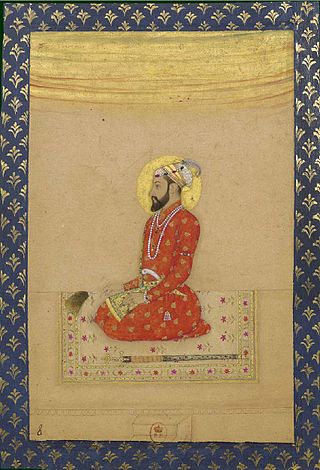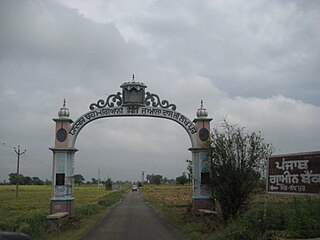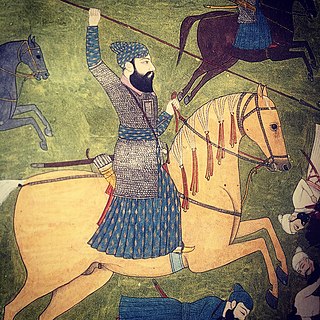
Mirza Muhammad Mu'azzam, commonly known as Bahadur Shah I and Shah Alam I, was the eighth Mughal Emperor from 1707 to 1712. He was the second son of the sixth Mughal Emperor Aurangzeb, who he conspired to overthrow in his youth. He was also governor of the imperial provinces of Agra, Kabul and Lahore and had to face revolts of Rajputs and Sikhs.

A zamindar in the Indian subcontinent was an autonomous or semi-autonomous feudal ruler of a zamindari. The term itself came into use during the reign of Mughals, Marathas and later the British had begun using it as a native synonym for "estate". The term means landowner in Persian. They were typically hereditary, and held the right to collect tax on behalf of imperial courts or for military purposes.

Jalandhar district is a district in Doaba region of the state of Punjab, India. The district headquarters is the city of Jalandhar.

Doaba, also known as Bist Doab or the Jalandhar Doab, is the region of Punjab, India that lies between the Beas River and the Sutlej River. People of this region are given the demonym "Doabia". The dialect of Punjabi spoken in Doaba is called "Doabi". The term "Doaba" or "Doab" is derived from Persian دو آب meaning "land of two rivers". The river Sutlej separates Doaba from the Malwa region to its south and the river Beas separates Doaba from the Majha region to its north.

Majha is a region located in the central parts of the historical Punjab region split between India and Pakistan. It extends north from the right banks of the river Beas, and reaches as far north as the river Jhelum. People of the Majha region are given the demonym "Mājhī" or "Majhail". Most inhabitants of the region speak the Majhi dialect, which is the basis of the standard register of the Punjabi language. The most populous city in the area is Lahore on the Pakistani side, and Amritsar on the Indian side of the border.
Malwa is a geographical region in the south of Punjab state in India. It is located between south of the Sutlej river, north of the Ghaggar river, east of Pakistan, and west of the Sivalik Hills.
Mahilpur is a city and a Nagar Panchayat in Hoshiarpur district in the Indian state Punjab. It is situated on Hoshiarpur to Garhshankar stretch of State Highway 24. It is famous for the game of football in the region. Mahilpur is connected by road to nearby districts, states such as Jaijon, Jalandhar, Pathankot, Mohali, Chandigarh. Mahilpur is a development block. Mahilpur block has 140 villages in it. It as also known as the soccer-town of India given the craze of football among the people of Mahilpur town and its surrounding villages. It belongs to the Kandi area in the Doaba region of Punjab.
Rahon is a city and a municipal council in the district Shaheed Bhagat Singh Nagar of the Indian state of Punjab. Rahon is in Doaba region of Punjab. Doaba also known as Bist Doab, is the region of Punjab, India that lies between the Beas River and the Sutlej River. A famous battle was fought here between Sikhs and Mughals i.e Battle of Rahon (1710).
Lakhi Jungle is a village in the district of Bathinda in Punjab, India. It is situated 15 km from the city of Bathinda, on the way to Muktsar. The historic Gurdwara Lakhi Jungle Sahib is located on the outskirts of the village.

Ram Rai Pur is a village in Shaheed Bhagat Singh Nagar district. The village is located in the eastern part of Punjab, India. It is situated on the right bank of the Sutlej which is one of the 5 main rivers in Punjab. It is also one of the oldest villages in Punjab with a history dating back to the 17th century.

Lakhpur is a village near Sahni (Lakhpur-Sahni), Tehsil Phagwara, Kapurthala district, in Punjab, India.

Banda Singh Bahadur, was a Sikh warrior and a general of the Khalsa Army. At age 15, he left home to become an ascetic, and was given the name Madho Das Bairagi. He established a monastery at Nānded, on the bank of the river Godāvarī. In 1707, Guru Gobind Singh accepted an invitation to meet Mughal Emperor Bahadur Shah I in southern India, he visited Banda Singh Bahadur in 1708. Banda became disciple of Guru Gobind Singh and was given a new name, Gurbaksh Singh(as written in Mahan Kosh), after the baptism ceremony. He is popularly known as Banda Singh Bahadur. He was given five arrows by the Guru as a blessing for the battles ahead. He came to Khanda, Sonipat and assembled a fighting force and led the struggle against the Mughal Empire.
The siege of Jalalabad occurred in 1710 between the Mughal forces of Jalal Khan and the Sikh forces of Banda Singh Bahadur. Banda Singh Bahadur attacked the Mughal stronghold of Jalalabad. The army opposing Banda Singh was composed of a sizeable number of the Mughal zamindars and shurafa, including many Sadat, Banda Singh Bahadur repelled Mughal and Pathan forces after four days from the battlefield and back into the town, but failed to capture the town and withdrew.

Ahmad Shah Durrani, the founder of the Durrani Empire, invaded Indian subcontinent for eight times between 1748 and 1767, following the collapse of Mughal Empire in the mid-18th century. His objectives were met through the raids and deepened the political crisis in India.

Singhpuria Misl, also known as the Faizulpuria Misl, was founded by the Sikh warrior Nawab Kapur Singh, a Virk Jat who was born in 1697 and later became a prominent Khalsa leader. The misl took its original name from a village Faizullapur in Amritsar and then changed the name of the village to Singhpura, with the misl eventually following.

The Battle of Rahon was fought between Sikhs and Mughal Empire on 11 October 1710.

Ramgarhia Misl was a sovereign state (misl) in the Sikh Confederacy of Punjab region in present-day India and Pakistan. The misl's name is derived from Qila Ramgarh, a place located in Ramsar, near Amritsar, which was fortified and redesigned by Ramgarhia Misl chief Jassa Singh Ramgarhia. The Ramgarhia Misl was one of the twelve major Sikh misls, and held land near Amritsar.

Duhre is a village in Jalandhar district of Punjab State, India. It is located 24 kilometres (15 mi) from district headquarter Jalandhar and 166 kilometres (103 mi) from state capital Chandigarh. The village is administrated by a sarpanch who is an elected representative of village as per Panchayati raj (India).
The Battle of Mahilpur was fought between the Sikh Misls and Adina Beg Khan against the Durrani Empire in December 1757.Following the 4th invasion of Ahmad Shah Durrani, he would appoint Timur Shah as the viceroy of Punjab with Jahan Khan as his deputy.The Afghans would appoint Adina Beg Khan as the faujdar of the Jalandhar Doaba and exempted him from attending court at lahore, on the condition that Adina Beg pay revenue to the Afghan government.Soon a dispute regarding the payment of revenue occurred between Adina Beg and the Afghans.This dispute soon escalated which resulted in Jahan Khan sending an Afghan force to arrest Adina Beg.Adina Beg formed a military alliance with the Sikhs under the command of Jassa Singh Ahluwalia and Vadbhag Singh Sodhi.Adina Beg also gained the support of Sadiq Beg Khan, Khwaja Mirza Khan, and Raja Bhup Singh.Adina Beg along with the Sikh forces fought the Afghans at Mahilpur.The battle resulted in a victory for Adina Beg and the Sikhs and resulted in the entire Jalandhar Doaba being occupied and sacked by the Sikh forces.
Isa Khan Manj, was a Punjabi Muslim warlord from the Manj tribe of the cis-Sutlej territory in the Mughal Empire. He is credited with the killing of the Mughal prince Azam Shah during the Battle of Jajau, and for establishing an independent territory that defied Mughal authority.











